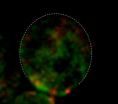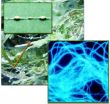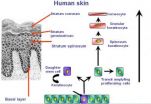(Press-News.org) Light-sensing cells in the eye rely on their outer segment to convert light into neural signals that allow us to see. But because of its unique cylindrical shape, the outer segment is prone to breakage, which can cause blindness in humans. A study published by Cell Press on January 22nd in the Biophysical Journal provides new insight into the mechanical properties that cause the outer segment to snap under pressure. The new experimental and theoretical findings help to explain the origin of severe eye diseases and could lead to new ways of preventing blindness.
VIDEO:
This video explains how mutant opsin aggregates in rod photoreceptor outer segments.
Click here for more information.
"To our knowledge, this is the first theory that explains how the structural rigidity of the outer segment can make it prone to damage," says senior study author Aphrodite Ahmadi of the State University of New York Cortland. "Our theory represents a significant advance in our understanding of retinal degenerative diseases."
The outer segment of photoreceptors consists of discs packed with a light-sensitive protein called rhodopsin. Discs made at nighttime are different from those produced during the day, generating a banding pattern that was first observed in frogs but is common across species. Mutations that affect photoreceptors often destabilize the outer segment and may damage its discs, leading to cell death, retinal degeneration, and blindness in humans. But until now, it was unclear which structural properties of the outer segment determine its susceptibility to damage.
To address this question, Ahmadi and her team examined tadpole photoreceptors under the microscope while subjecting them to fluid forces. They found that high-density bands packed with a high concentration of rhodopsin were very rigid, which made them more susceptible to breakage than low-density bands consisting of less rhodopsin. Their model confirmed their experimental results and revealed factors that determine the critical force needed to break the outer segment.
VIDEO:
This video explains how vision is affected by a bending rod.
Click here for more information.
The findings support the idea that mutations causing rhodopsin to aggregate can destabilize the outer segment, eventually causing blindness. "Further refinement of the model could lead to novel ways to stabilize the outer segment and could delay the onset of blindness," says Ahmadi.
INFORMATION:
Biophysical Journal, Haeri et al.: "Modeling the Flexural Rigidity of Rod Photoreceptors."
Study of how eye cells become damaged could help prevent blindness
2013-01-22
ELSE PRESS RELEASES FROM THIS DATE:
Controlling spine metastases with tumor 'separation surgery' and high-dose stereotactic radiosurgery
2013-01-22
Charlottesville, VA (January 22, 2013). Researchers from Memorial Sloan-Kettering Cancer Center (New York, NY) have found that tumor "separation surgery" followed by high-dose hypofractionated stereotactic radiosurgery (SRS) or high-dose single-fraction SRS is safe and effective in controlling spinal metastases regardless of the radiosensitivity of the particular tumor type that has invaded the spine. This finding is fleshed out in the article "Local disease control for spinal metastases following 'separation surgery' and adjuvant hypofractionated or high-dose single-fraction ...
Evidence mounts for role of mutated genes in development of schizophrenia
2013-01-22
Johns Hopkins researchers have identified a rare gene mutation in a single family with a high rate of schizophrenia, adding to evidence that abnormal genes play a role in the development of the disease.
The researchers, in a report published in the journal Molecular Psychiatry, say that family members with the mutation in the gene Neuronal PAS domain protein 3 (NPAS3) appear at high risk of developing schizophrenia or another debilitating mental illnesses.
Normally functioning NPAS3 regulates the development of healthy neurons, especially in a region of the brain known ...
A diffusion trap
2013-01-22
KANSAS CITY, MO – Over the past several years, Rong Li, Ph.D., at the Stowers Institute for Medical Research has been making crucial discoveries about the development of cell polarity—the process by which one side of a cell becomes different from the other side. Such polarity is critical for the functioning of the vast majority of cells. The outside surface of skin cells is very different from the surface inside the body, for example, while nerve cells have delicately branching dendrites on one end and axons on the other. Li's lab studies yeast cells, which form a unique ...
Synchrotron infrared unveils a mysterious microbial community
2013-01-22
In the fall of 2010, Hoi-Ying Holman of the U.S. Department of Energy's Lawrence Berkeley National Laboratory (Berkeley Lab) was approached by an international team researching a mysterious microbial community discovered deep in cold sulfur springs in southern Germany.
"They told me what they were doing and said, 'We know what you contributed to the oil-spill research,'" recalls Holman, who heads the Chemical Ecology group in Berkeley Lab's Earth Sciences Division. "They wondered if I could help them determine the biochemistry of their microbe samples."
Holman had ...
Immune cells engineered in lab to resist HIV infection, Stanford study shows
2013-01-22
STANFORD, Calif. — Researchers at the Stanford University School of Medicine have found a novel way to engineer key cells of the immune system so they remain resistant to infection with HIV, the virus that causes AIDS.
A new study describes the use of a kind of molecular scissors to cut and paste a series of HIV-resistant genes into T cells, specialized immune cells targeted by the AIDS virus. The genome editing was made in a gene that the virus uses to gain entry into the cell. By inactivating a receptor gene and inserting additional anti-HIV genes, the virus was blocked ...
Sex of early birds suggests dinosaur reproductive style
2013-01-22
In a paper published in Nature Communications on January 22, 2013, a team of paleontologists including Dr. Luis Chiappe, Director of the Natural History Museum of Los Angeles County's (NHM) Dinosaur Institute, has discovered a way to determine the sex of an avian dinosaur species.
Confuciusornis sanctus, a 125-million-year-old Mesozoic bird, had remarkable differences in plumage — some had long, almost body length ornamental tail feathers, others had none — features that have been interpreted as the earliest example of avian courtship. However, the idea that male Confuciusornis ...
The skin aging regulator
2013-01-22
These mechanisms, described in vivo in mice, engage molecule CD98hc, which is involved in epidermis renewal and could be an indicator of the skin's capacity for regeneration.
The results were published in the Journal of Experimental Medicine review.
The epidermis, the surface layer of the skin, is mainly composed of keratinocytes cells, which, in humans, are renewed continuously over a 21-day cycle. These cells are located on a membrane made up of components from the extracellular matrix that provides the junction with the dermis, the deep layer of the skin (see diagram). ...
Harmful effects of bisphenol A proved experimentally
2013-01-22
Bisphenol A (BPA) is a chemical compound that is included in the composition of plastics and resins. It is used, for example, in the manufacture of food containers such as bottles and babies' feeding bottles. It is also found in the protective films used inside food and drink cans and on till receipts where it used as a discloser. Significant levels of BPA have also been found in human blood, urine, amniotic fluid and placentas. Recent studies have shown that this industrial component has harmful effects on reproductive ability, development and the metabolism of laboratory ...
Analysis of fracking wastewater yields some surprises
2013-01-22
DURHAM, N.C. -- Hydraulically fractured natural gas wells are producing less wastewater per unit of gas recovered than conventional wells would. But the scale of fracking operations in the Marcellus shale region is so vast that the wastewater it produces threatens to overwhelm the region's wastewater disposal capacity, according to new analysis by researchers at Duke and Kent State universities.
Hydraulically fractured natural gas wells in the Marcellus shale region of Pennsylvania produce only about 35 percent as much wastewater per unit of gas recovered as conventional ...
EARTH: The dangers of solar storms
2013-01-22
Alexandria, VA – Throughout history, humanity has steadily increased its dependence upon technology. Although technology has vastly improved the quality of life for billions of people, it has also opened us up to new risks and vulnerabilities. Terrorism and natural disasters might be at the forefront of the minds of policymakers and the U.S. population, but a significant threat lurks over our heads: the sun. A massive solar storm, the size last seen a century and a half ago, could easily leave hundreds of millions of people in the dark for days, weeks or even months.
The ...



